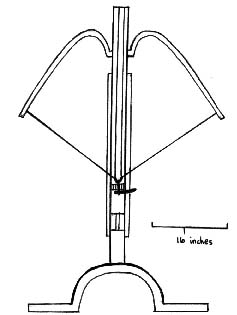Military Technology of the Roman Empire
Evolution of the Sword
 One of the first of the Roman swords. They decided to use this
sword when they encountered in France. This sword was approximately
30 inches long and 2 inches wide. This may have not been an official
Roman Empire sword mainly because only one has been found and there is no
evidence to back up this asssumption. This type of sword was called
the gladius Hispaniensis. (see above)
One of the first of the Roman swords. They decided to use this
sword when they encountered in France. This sword was approximately
30 inches long and 2 inches wide. This may have not been an official
Roman Empire sword mainly because only one has been found and there is no
evidence to back up this asssumption. This type of sword was called
the gladius Hispaniensis. (see above)
The first type of evolution of the Roman sword was
called the "Pompeii" type. This sword was about 16 inches by 2 inches,
was double edged, and had a sharp point at the end. These swords
were made a little before 79 AD. The Pompeii sword was probably one
of the most famous swords because they are carved onto most of the famous
structures from the Roman Empire.
A different type of sword from around the same time
as the Pompeii sword was the spatha. The spatha was a calvary sword
of that time and only consisted of a single edged sword. The dimensions
of the spatha were about 27 inches. This calvary sword was also one
of the few swords that were also made in steel. Most swords were made
out of iron because when reheated and cooled, the iron makes strips of
steel within the blade. The longest spatha found in Denmark reaching
40 inches.

Minor changes were brounght
to the swords after the introduction of the
Pompeii and the spatha. The “classic Roman sword” ended having the
blade between 25 and 30 inches long, the guard was very narrow, and the hilt was topped with a rounded ball.
(see right) The classical Roman sword also
became double sided.
Evolution of Artillery
Artillery first started with
bows called non-torsion bows. These are bows that do not use the tension of animal tendons and/or animal hair. Non-tension
intruments use the tension of wood. One of the first non-tension weapons was called the gastraphetes. The gastraphetes
looked like a bow and was so big that in order to pull back the bow, you had to support it against your body. The
string would be brought back in successive hitches until it could be released.
(see right) When the advancements of these weapons caused them to
become bigger, pulley methods were necessary to pull the arms back. The bows eventually
had to be stuck into the ground because the bow could not be pulled back
individually.
Torsion weapons started at
around this time also. The torsion weapons were like crude bows used
today. They were put together specifically to make sure the arm had
a lot of mobility and that the tension from the hair or tendons of an animal
caused the arrow or bolt to travel a greater distance. The advancements
of these weapons over time became slight. One of the most important
advancements was the use of a recurved bow instead of an arch. This
new arrangement caused greater power in the bow. One of the most famous
bows was called the onager. The onager was one of those machines in
which boulders are hurled from. They only have one arm in which it
is pulled down by a spring. This weapon was the largest weapon used
in the Roman Empire. Clearly the artillery of the Roman Empire was
advanced and unique compared to its enemies and allies.
Other Military Advancements
Other military advancements
were the Romans adapted form of the phalanx. Instead of tightly woven
phalanx, they gave the group more room allowing more maneuverability on
the battlefield. The Romans also invented a formation called the testudo.
The soldiers would put their shields infront of them or on top of
them forming almost an impenatrable box. This formation was helpful
when they were under increased fire. Besides their gladius, soldiers
wore caliga (leather shoes), a bronze helmet with cheek plates, a coat
of iron mail, two pilum (spears), a pugio (short dagger), and a scutum
(a wooden shield). These military advancements also helped the Roman
Empire with their victories on the battlefield.
back to home page

 One of the first of the Roman swords. They decided to use this
sword when they encountered in France. This sword was approximately
30 inches long and 2 inches wide. This may have not been an official
Roman Empire sword mainly because only one has been found and there is no
evidence to back up this asssumption. This type of sword was called
the gladius Hispaniensis. (see above)
One of the first of the Roman swords. They decided to use this
sword when they encountered in France. This sword was approximately
30 inches long and 2 inches wide. This may have not been an official
Roman Empire sword mainly because only one has been found and there is no
evidence to back up this asssumption. This type of sword was called
the gladius Hispaniensis. (see above)
